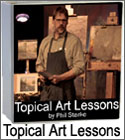Category Archives for Supplies
Unprimed Hardboard Masonite Boards
 If you like painting on a toned board, a good surface is a masonite, or hardboard panel, without any gesso or primer. The boards have a nice warm tone to them and I find it easier to judge values on a darker surface. They do need to be sealed so I use a clear shellac, sprayed or brushed on. I use this for smaller boards, 10 x 12 and smaller. The surface gets too slick with larger boards.
If you like painting on a toned board, a good surface is a masonite, or hardboard panel, without any gesso or primer. The boards have a nice warm tone to them and I find it easier to judge values on a darker surface. They do need to be sealed so I use a clear shellac, sprayed or brushed on. I use this for smaller boards, 10 x 12 and smaller. The surface gets too slick with larger boards.
Home improvement stores carry these boards and they will cut them for you. I do recommend the spray shellac, it’s easier and less messy. I apply 3 coats of shellac about 10 minutes drying time between each coat.
Unprimed Hardboard Masonite Boards
 If you like painting on a toned board, a good surface is a masonite, or hardboard panel, without any gesso or primer. The boards have a nice warm tone to them and I find it easier to judge values on a darker surface. They do need to be sealed so I use a clear shellac, sprayed or brushed on. I use this for smaller boards, 10 x 12 and smaller. The surface gets too slick with larger boards.
If you like painting on a toned board, a good surface is a masonite, or hardboard panel, without any gesso or primer. The boards have a nice warm tone to them and I find it easier to judge values on a darker surface. They do need to be sealed so I use a clear shellac, sprayed or brushed on. I use this for smaller boards, 10 x 12 and smaller. The surface gets too slick with larger boards.
Home improvement stores carry these boards and they will cut them for you. I do recommend the spray shellac, it’s easier and less messy. I apply 3 coats of shellac about 10 minutes drying time between each coat.
New Topical Lessons on Starke Studio Web Site
 In my newsletter I’ve been talking about changes coming to my teaching materials and this month the first of those new materials have become available. So if you get my newsletter, you know what I’m talking about. I’ve put together topical lessons to address individual challenges artists face. The lessons come with a video demonstration, but along with the demonstration I include a lesson plan for continued study and application. These new topical lessons are available in two ways. If the lessons are ordered through the mail, a three-ringed binder will be sent with the first lesson ordered so that lesson and any subsequent lessons ordered can be kept together to help with organization. The second way the lessons can be ordered is through “direct download”. A notebook does not come with the download format, but there aren’t any shipping costs with the download option. New “Full Length Feature Demos” are coming as well. So a lot is happening over at Starke Studio. Stop by and check out the new stuff now at www.StarkeStudio.com.
In my newsletter I’ve been talking about changes coming to my teaching materials and this month the first of those new materials have become available. So if you get my newsletter, you know what I’m talking about. I’ve put together topical lessons to address individual challenges artists face. The lessons come with a video demonstration, but along with the demonstration I include a lesson plan for continued study and application. These new topical lessons are available in two ways. If the lessons are ordered through the mail, a three-ringed binder will be sent with the first lesson ordered so that lesson and any subsequent lessons ordered can be kept together to help with organization. The second way the lessons can be ordered is through “direct download”. A notebook does not come with the download format, but there aren’t any shipping costs with the download option. New “Full Length Feature Demos” are coming as well. So a lot is happening over at Starke Studio. Stop by and check out the new stuff now at www.StarkeStudio.com.
When Oil Paint Doesn’t Dry Fast Enough
Usually, if I’m trying to alter the drying time of oils, it’s to speed it up to meet a deadline or to make changes over dry paint. But once in a while, like in portraiture or figure painting, it’s nice to flow down the drying time to achieve subtle changes over a longer period of time.
Oil of Cloves is one way of slowing the drying time. It’s a preservative that’s used to cover up the odor of decomposition. It has a pretty strong odor but it’s tolerable. A few drops in a paint mixture retards the drying time. Ralph Meyer’s book “The Artists Handbook of Materials and Techniques”
Traditional Gesso
I’ve been using acrylic gesso on small masonite panels lately, not having enough time to glue canvas to them and too cheap to buy pre-gessoed canvas panels and I’m finding the acrylic gesso is too slick. The oil paint doesn’t absorb into the surface enough. So I bought some Gamblin Traditional Gesso. It’s a mixture of marble dust, titanium dioxide and rabbit skin glue. It’s been used for centuries on wooden panels and is more absorbent. Just add water Continue Reading
Traditional Gesso
I’ve been using acrylic gesso on small masonite panels lately, not having enough time to glue canvas to them and too cheap to buy pre-gessoed canvas panels and I’m finding the acrylic gesso is too slick. The oil paint doesn’t absorb into the surface enough. So I bought some Gamblin Traditional Gesso. It’s a mixture of marble dust, titanium dioxide and rabbit skin glue. It’s been used for centuries on wooden panels and is more absorbent. Just add water Continue Reading
Using Brushstrokes to Show Form
Since painting is done on a flat surface and the goal is to make your subject look three dimensional, it’s important how your brushstrokes lay on the canvas. Using value changes gives flat objects form and so does temperature change — warm colors come forward and cool colors recede. Hard and soft edges do the same thing, softer edges recede to the background and hard edges stick out and stay in front.
Brush strokes can do the same thing. The video here Continue Reading
